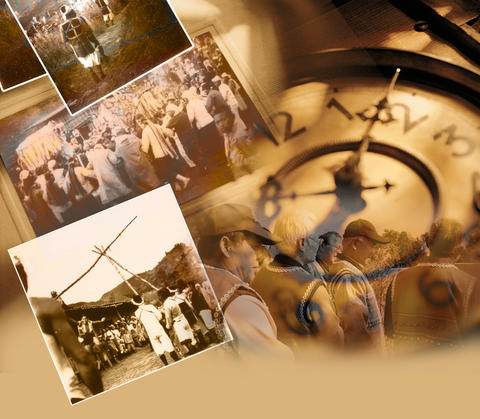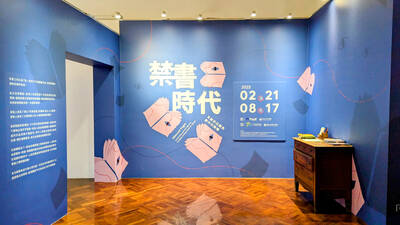Ominataro (朱秀春) slouches in his chair and stares at the blank projector screen in front of him in this 100-seat auditorium on a recent Saturday morning in a community hall in Ta-ai (大隘村), Hsinchu County. The sun shines on the village - nestled amongst dense vegetation at the bottom of a mountain range. He says an occasional word to the man sitting beside him, but otherwise concentrates on the white space in front of him.
A year earlier, the scene outside the hall was radically different from the subdued atmosphere today. At that time, more than 2,000 Aboriginal people from the Saisiat (賽夏) tribe gathered to celebrate the Pasta'ay Grand Ceremony (巴斯達隘10年大祭), a harvest ritual occurring every 10 years on the 15th day of the 10th lunar month that involves four days of dancing, chanting, singing and feasting. Its reputation was such that, according to Ominataro, 67, "There were so many people at the ceremony you couldn't even hear the songs being chanted. … We were happy, though, that our ritual garnered so much attention from outsiders."
Today, the assembled elders have arrived to watch Pasta'ay: The Saisiat Ceremony in 1936 (巴斯達隘: 1936年的賽夏祭典), a documentary of the rite filmed by Nobuto Miyamoto, a Japanese anthropologist working at the then Taipei Imperial University (now National Taiwan University, NTU). Lost in the dusty archives of an NTU storeroom for almost 60 years, the film was rediscovered in 1994, restored and first shown at last year's Taiwan International Ethnographic Film Festival (TIEFF, 台灣國際民族誌影展).

Photos courtesy of the Department of Anthropology, NTU
The documentary's history is intertwined with the tribe's struggle to maintain an important event in the face of Japan's cultural homogenization agenda, the policies of which forced the island's people - both Taiwanese and Aboriginal - to give up their own culture and language in favor of Japan's. Its filming also provides a close-up look at how the Saisiat celebrated the rite 70 years ago - and how little it has changed over time.
Saisiat resist oppression
Unlike other documentaries filmed during the 50 years of Japanese colonization - which Hu Tai-li (胡台麗), a research fellow at the Academia Sinica's Institute of Ethnology says were usually propaganda films glorifying Japan's achievements - Pasta'ay: The Saisiat Ceremony in 1936 was made because the Saisiat wanted to show local Japanese authorities how important the festival was to the tribe.
"[The Saisiat] invited the anthropologists because the local county government planned to stop the ritual in the 1930s," said Hu Chia-yu (胡家瑜), an associate professor of anthropology at NTU who has done research on the Saisiat.
"The [Japanese] government forbade [different settlements] from getting together because they were afraid that indigenous people [would] revolt," she said. "A lot of [Aboriginal] rituals stopped at that time."
With memories of the Beipu (北埔) Incident, a Saisiat uprising in 1907, fresh in their minds, the Japanese had good reason - from a colonial mindset at least - to fear that plans for another revolt could be hatched at one of these gatherings.
"The head of a Saisiat village knew the Japanese were planning to stamp out the ritual so the tribe acted very quickly and organized a clan meeting," Hu said. "If the Japanese government tried to stop the ritual, they would have revolted again."
The Saisiat hold the Pasta'ay ceremony in reverence to the Short Black People (矮靈祭) - a legendary pygmy race that passed to the Saisiat their knowledge of agriculture, medicine, rice wine making and folklore. Much of this knowledge was given in the form of songs and dances, which the Saisiat believe they must perform, or they themselves will perish.
After making the documentary, Miyamoto used the film to convince the local Japanese magistrate that the event was a necessary part of Saisiat culture and canceling it would only cause headaches for the authorities.
Hu says that after the Japanese authorities saw the documentary, they arrived at a compromise with the tribe: Rather than canceling the ceremony, which at the time occurred annually with a grand ceremony held every 10 years, they agreed that the tribe's northern and southern ritual groups could individually celebrate the Pasta'ay biannually and together once every 10 years.
Standing firm for the future
Back in the community center, silence falls in the auditorium as the silent documentary begins. Then murmuring can be heard and members of the audience begin to shout out the names of people in the documentary who they recognize. At the conclusion of roughly 15 minutes of footage, the elders demand to see it again because the images appeared too fleetingly across the screen to determine people and places.
At the end of the second showing, which took considerably longer than the first because the elders kept calling on the assistants to slow the projection down, the assembled elders stood to give their impressions.
Noting the similarities between the celebration that took place 70 years ago and the one last year, Mamavale, also a Saisiat elder, says, "This documentary shows that, like food, the Saisiat are capable of preserving that which gives Aboriginal people nourishment. Where other tribes discard the fruits of their harvest, the Saisiat retain the riches from the ground. Other Aboriginal people change their rituals, only the Saisiat preserve them."
Though Mamavale's view may be an exaggeration, the tribe did maintain an important rite in the face of colonizing powers determined to stamp it out.
After the screening, Hu, who is encouraging Aboriginal people to take a more active role in their cultural preservation, hands out DVDs of the documentary to tribal elders.
TIEFF last year used Indigenous Voices as its central theme and encouraged Aboriginal peoples to speak out in their own voices. The topic of that festival prompted Aboriginal groups from around the world to change from being the subjects of documentary filmmaking to recording their own stories.
Another elder stands up and says, "Before, the history of the Saisiat was written by other people. After watching this documentary, I hope the Saisiat people can encourage each other to write their own history."

On the final approach to Lanshan Workstation (嵐山工作站), logging trains crossed one last gully over a dramatic double bridge, taking the left line to enter the locomotive shed or the right line to continue straight through, heading deeper into the Central Mountains. Today, hikers have to scramble down a steep slope into this gully and pass underneath the rails, still hanging eerily in the air even after the bridge’s supports collapsed long ago. It is the final — but not the most dangerous — challenge of a tough two-day hike in. Back when logging was still underway, it was a quick,

From censoring “poisonous books” to banning “poisonous languages,” the Chinese Nationalist Party (KMT) tried hard to stamp out anything that might conflict with its agenda during its almost 40 years of martial law. To mark 228 Peace Memorial Day, which commemorates the anti-government uprising in 1947, which was violently suppressed, I visited two exhibitions detailing censorship in Taiwan: “Silenced Pages” (禁書時代) at the National 228 Memorial Museum and “Mandarin Monopoly?!” (請說國語) at the National Human Rights Museum. In both cases, the authorities framed their targets as “evils that would threaten social mores, national stability and their anti-communist cause, justifying their actions

In the run-up to World War II, Admiral Wilhelm Canaris, head of Abwehr, Nazi Germany’s military intelligence service, began to fear that Hitler would launch a war Germany could not win. Deeply disappointed by the sell-out of the Munich Agreement in 1938, Canaris conducted several clandestine operations that were aimed at getting the UK to wake up, invest in defense and actively support the nations Hitler planned to invade. For example, the “Dutch war scare” of January 1939 saw fake intelligence leaked to the British that suggested that Germany was planning to invade the Netherlands in February and acquire airfields

The launch of DeepSeek-R1 AI by Hangzhou-based High-Flyer and subsequent impact reveals a lot about the state of the People’s Republic of China (PRC) today, both good and bad. It touches on the state of Chinese technology, innovation, intellectual property theft, sanctions busting smuggling, propaganda, geopolitics and as with everything in China, the power politics of the Chinese Communist Party (CCP). PLEASING XI JINPING DeepSeek’s creation is almost certainly no accident. In 2015 CCP Secretary General Xi Jinping (習近平) launched his Made in China 2025 program intended to move China away from low-end manufacturing into an innovative technological powerhouse, with Artificial Intelligence